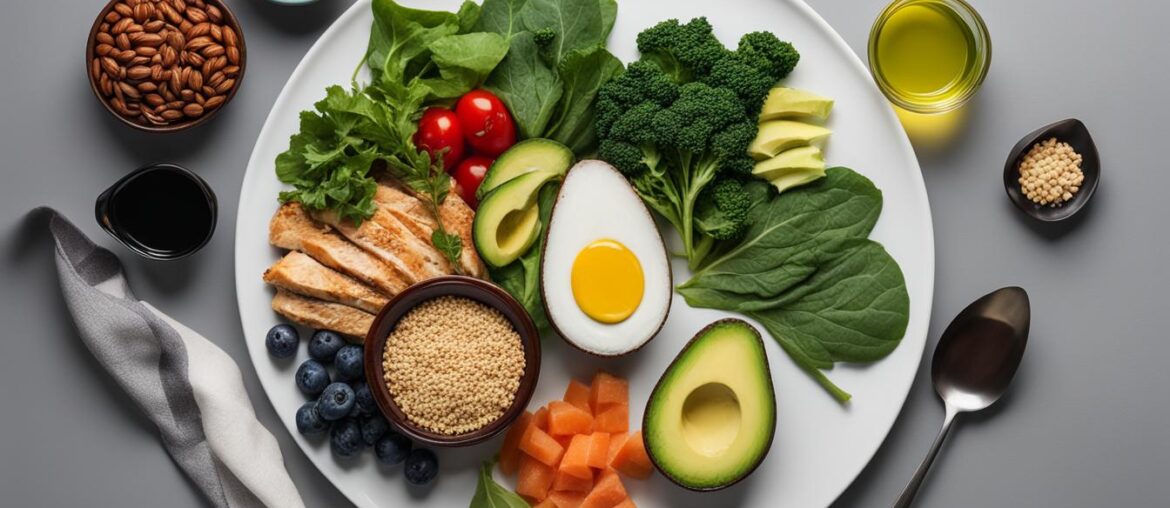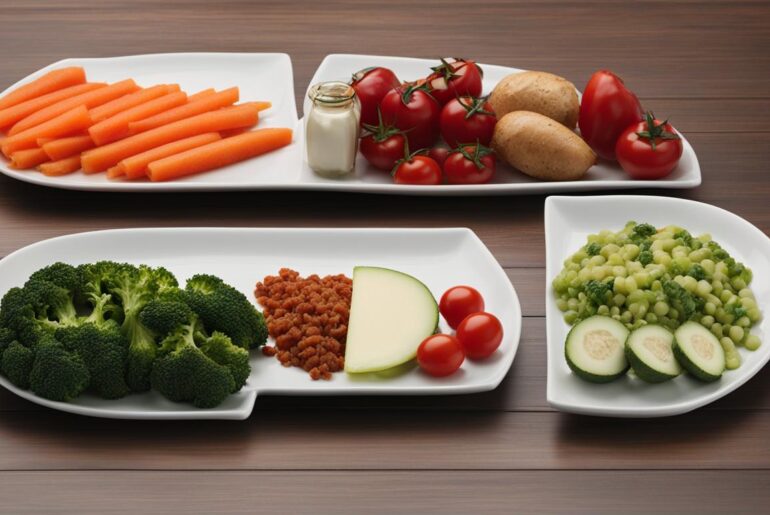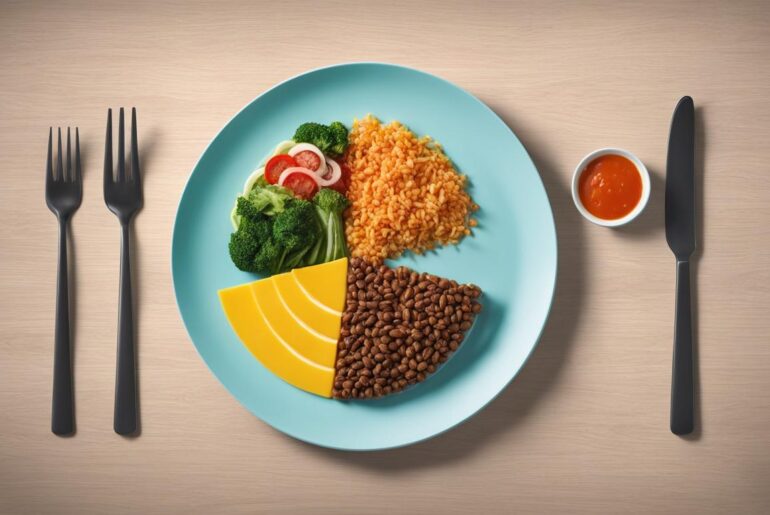When I first started my journey with the ketogenic diet, I believed that I could eat to my heart’s content without worrying about portion control. After all, the high-fat nature of the diet seemed like a free pass to indulge in as much food as I wanted. However, I quickly learned that portion control plays a crucial role in success on the keto diet.
Implementing portion control not only helps with weight loss but also prevents overeating, which can hinder progress on the ketogenic diet. It’s important to have a balanced meal that includes the appropriate proportions of fats, proteins, and carbohydrates. While the primary focus of the keto diet is on fats, it’s essential to moderate protein intake and limit carbohydrate consumption to non-starchy vegetables.
Mindful eating became my secret weapon for portion control on keto. By paying attention to my hunger signals and being aware of portion sizes, I was able to prevent overindulgence and maintain a caloric deficit. I also found visual cues to be helpful, such as using smaller plates and pre-measuring servings. These strategies allowed me to enjoy the benefits of the keto diet while still managing portion sizes.
Key Takeaways:
- Portion control is necessary for success on the keto diet.
- A balanced meal with appropriate proportions of fats, proteins, and carbohydrates is essential.
- Mindful eating and visual cues, such as using smaller plates, can help with portion control.
- Implementing portion control prevents overeating and promotes weight loss on keto.
- Understanding your hunger signals and practicing portion control aids in maintaining a caloric deficit.
The Role of Portion Control on the Keto Diet
Portion control plays a crucial role on the ketogenic diet to achieve weight loss and maintain overall health. Consuming more calories than the body burns, even on keto, can hinder weight loss efforts. Understanding proper portion sizes and distributing macronutrients (fats, proteins, and carbs) according to the recommended keto macro ratio is important. Portion control helps prevent weight loss plateaus and potential health issues associated with overconsumption of calories and imbalanced macronutrients.
On the ketogenic diet, the primary goal is to achieve a state of ketosis, where the body burns fat for fuel instead of carbohydrates. Managing portion sizes is essential in order to control calorie intake and maintain the optimal macronutrient ratios required for ketosis. While the diet primarily focuses on high fat and low carbohydrate content, proper portioning ensures that the body is receiving the right amount of nutrients without excess calories.
Implementing portion control on the keto diet helps prevent weight loss plateaus. In the absence of proper portioning, it is easy to unknowingly consume more calories than the body needs, which can stall weight loss progress. By practicing portion control, individuals can effectively manage their caloric intake and maintain a consistent level of weight loss.
Moreover, portion control is essential for maintaining overall health on the ketogenic diet. Overconsumption of calories, even from sources high in healthy fats, can lead to weight gain and potential health issues such as high cholesterol and cardiovascular problems. By carefully portioning meals, individuals can ensure they are not consuming excessive amounts of calories and can maintain a healthy balance of macronutrients.
Understanding proper portion sizes is a key aspect of portion control on the keto diet. Each meal should consist of a balanced combination of fats, proteins, and carbohydrates. However, the ratio of these macronutrients may vary depending on an individual’s specific goals and requirements.
To illustrate the recommended macronutrient distribution on the keto diet, refer to the following table:
| Macronutrient | Percentage of Daily Caloric Intake |
|---|---|
| Fats | 70-80% |
| Proteins | 20-25% |
| Carbohydrates | 5-10% |
Following this macronutrient breakdown and practicing portion control ensures that the body is receiving an adequate amount of fats, proteins, and carbohydrates for energy and nourishment while still promoting ketosis.
Incorporating portion control on the keto diet not only aids in weight loss but also helps optimize overall health and well-being. By being mindful of portion sizes and understanding the importance of balanced macronutrient distribution, individuals can achieve their desired results on the ketogenic diet.
Tips for Portion Control on Keto
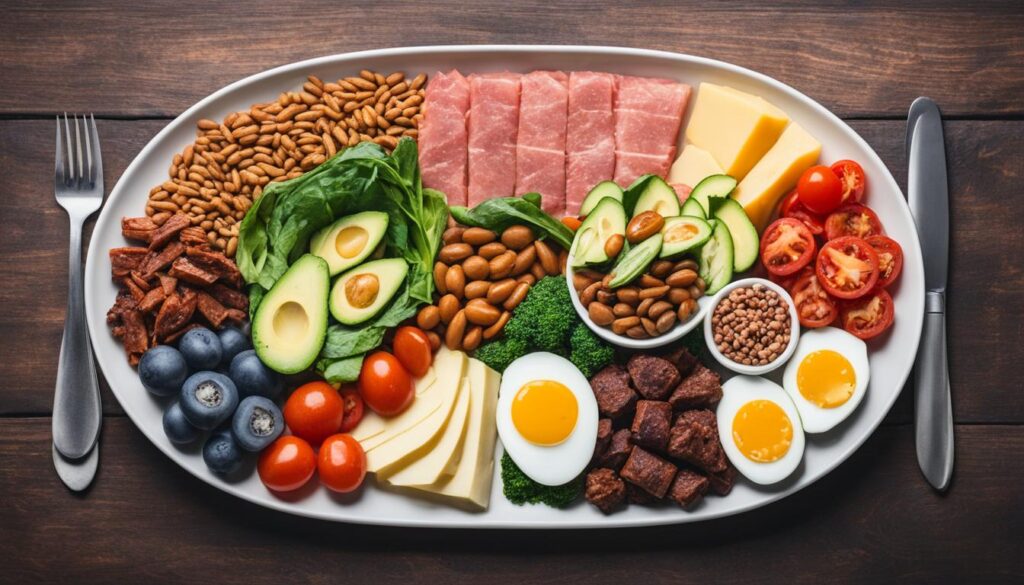
Implementing portion control on keto can be challenging, but there are effective tips and practices to manage it. Here are some key strategies to help you control your portion sizes and maintain your ketogenic diet:
1. Use Smaller Plates
Opt for smaller plates and bowls when serving your meals. This trick creates the illusion of a larger portion while still controlling the amount of food you consume.
2. Pre-Measure Servings
Pre-measure your food portions using measuring cups or a food scale (check out my post on using measuring cups here). This ensures accuracy and helps prevent overeating.
3. Hydrate with Water
Drink a glass of water before each meal to help fill you up and prevent overeating. Dehydration can often be mistaken for hunger, so staying hydrated is essential for portion control.
4. Pay Attention to Macronutrient Ratios
Balance your meals by paying attention to the macronutrient ratios – fats, proteins, and carbohydrates. Aim to consume the appropriate amounts of each macronutrient, as this will help control cravings and manage portion sizes.
5. Meal Prep
Plan and prepare your meals in advance. This allows you to portion out your meals ahead of time, making it easier to stick to your portion control goals.
6. Utilize Portion Control Tools
Consider using portion control tools such as portion control plates or containers (check out my post on portion control plates here). These tools help guide you in portioning out your meals correctly.
By implementing these tips and practices, you can effectively manage portion control on your keto diet and maintain your weight loss goals.
Understanding Macronutrients on Keto
Each macronutrient (fats, proteins, and carbohydrates) plays a vital role in supporting the body’s needs during a ketogenic diet. It is essential to understand the appropriate macro ratios and portion control for each macronutrient to achieve success on keto.
Fats: Fats are a primary source of energy on the keto diet. They help fuel the body and promote satiety. It is important to choose healthy fats such as avocados, nuts, and oils, and portion them correctly to maintain the desired caloric intake.
Proteins: Proteins are crucial for muscle growth, repair, and overall health. While protein is important, excessive consumption can hinder ketosis. It is recommended to include moderate portions of lean meats, seafood, and eggs in your meals to stay within the recommended protein limits.
Carbohydrates: Carbohydrates on keto are limited to non-starchy vegetables. These vegetables provide essential micronutrients and fiber while minimizing blood sugar spikes. Portioning carbohydrates correctly ensures you maintain ketosis while enjoying the benefits of these nutrient-rich foods.
By balancing and portioning these macronutrients appropriately, you can achieve successful weight loss and maintain ketosis effectively.
Fat | Protein | Carbohydrate Ratio on Keto
Understanding the recommended macro ratios on keto is crucial for managing macronutrients effectively. The standard macronutrient ratio on keto is often referred to as the “70/25/5” ratio:
| Macronutrient | Percentage of Daily Calories | Example Foods |
|---|---|---|
| Fat | 70% | Avocado, olive oil, butter |
| Protein | 25% | Chicken breast, salmon, eggs |
| Carbohydrate | 5% | Leafy greens, broccoli, cauliflower |
Balancing your meals according to this ratio helps ensure you consume the appropriate amounts of each macronutrient. However, portion control is still crucial to avoid overeating and maintain a calorie deficit for weight loss. Monitoring your portion sizes diligently will contribute to your overall success on the keto diet.
Portion Control Strategies for Fats and Proteins on Keto
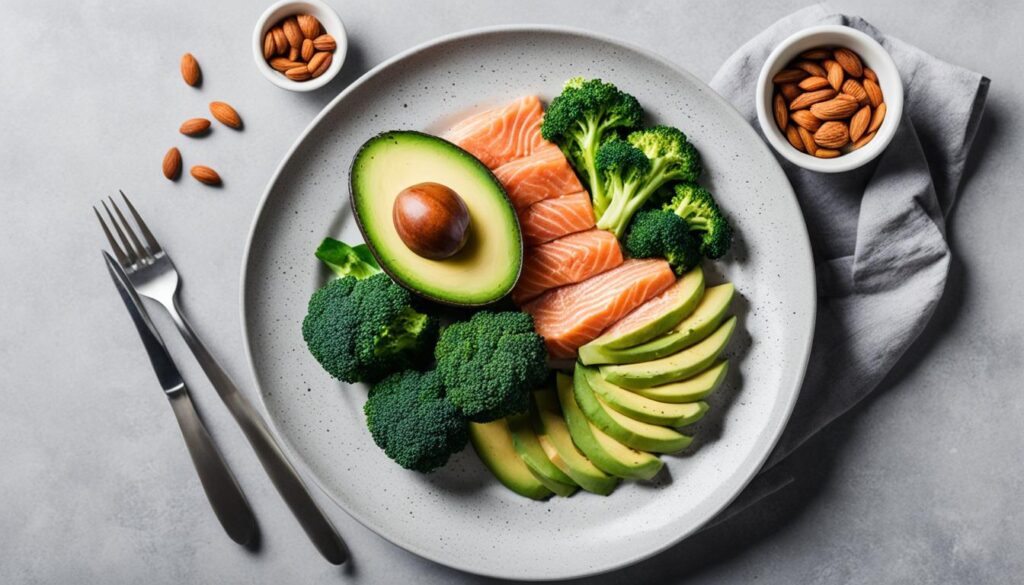
When following a keto diet, portion control is crucial for both fats and proteins. By consuming the appropriate amount of fats and portioning proteins correctly, you can maintain optimal energy levels, prevent overconsumption, and avoid disrupting ketosis.
Fats: It is important to choose healthy fats that are rich in essential nutrients. Incorporating foods such as avocado, nuts, and oils into your meals can provide the necessary fats while helping you feel satisfied. However, it is essential to practice portion control to ensure you don’t exceed your daily caloric intake.
Proteins: Lean meats, seafood, and eggs are excellent sources of protein on a keto diet. Protein is crucial for muscle growth and repair, but excessive consumption can lead to exceeding your protein limits and potentially kick you out of ketosis. By portioning your proteins according to the recommended serving sizes, you can maintain a well-balanced keto diet.
To help you visualize the appropriate portion sizes for fats and proteins on keto, refer to the table below:
| Fats | Recommended Portion Size |
|---|---|
| Avocado | 1/4 to 1/2 avocado |
| Nuts | 1 ounce (about a handful) |
| Oils (olive, coconut, etc.) | 1 tablespoon |
| Proteins | Recommended Portion Size |
|---|---|
| Lean Meats (chicken, turkey, beef) | 3 to 4 ounces (about the size of a deck of cards) |
| Seafood (salmon, tuna, shrimp) | 3 to 4 ounces |
| Eggs | 2 large eggs |
By incorporating these portion control strategies and following the recommended portion sizes for fats and proteins on keto, you can effectively manage your macronutrient intake and maintain a state of ketosis (check this post out).
The Role of Fibre in Portion Control on Keto
Including fibre in meals is crucial for portion control on keto. Fibre helps promote satiety, regulate appetite, and support healthy digestion. Consuming fruits, vegetables, whole grains, and legumes rich in fibre helps to feel fuller longer and prevents overeating. Fibre should be included in every meal, even on low-carb diets, as it provides benefits without causing weight gain or blood sugar spikes. Incorporating fibre into the diet is an effective strategy for managing portion control on keto.
| Foods Rich in Fibre | Amount of Fibre |
|---|---|
| Avocado | 6.7 grams per 100 grams |
| Broccoli | 2.6 grams per 100 grams |
| Chia Seeds | 34.4 grams per 100 grams |
| Flaxseeds | 27.3 grams per 100 grams |
| Almonds | 12.5 grams per 100 grams |
“Adding fibre to your meals not only helps with portion control but also provides numerous health benefits. Incorporate a variety of fibrous foods into your diet to feel satisfied and maintain a healthy weight.”
By including fibre-rich foods in your keto meals, you can enhance portion control and improve diet quality. These foods not only help you feel full and satisfied but also provide essential nutrients for overall health. Experiment with different fibre sources and incorporate them into tasty recipes to make portion control on keto a sustainable lifestyle choice.
Overcoming Challenges with Portion Control on Keto
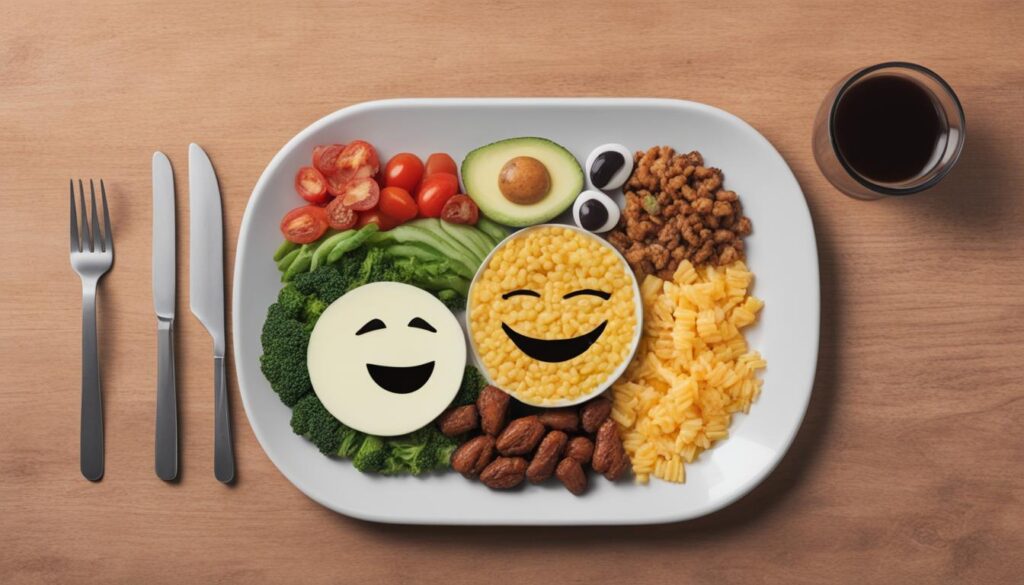
Portion control on keto can present its fair share of challenges, but there are effective strategies to overcome common obstacles. Emotional eating, eating while distracted, not drinking enough water, and skipping meals can all contribute to overeating and hinder your progress on the keto diet.
One of the key strategies for managing portion control on keto is implementing mindful eating practices. Taking the time to fully engage with your meal, savor each bite, and pay attention to your body’s hunger and fullness cues can help you better gauge your portion sizes and prevent overindulgence.
Eliminating distractions while eating is another important strategy. By putting away electronic devices, turning off the television, and focusing solely on your meal, you can be more attuned to your body’s signals of satisfaction and prevent mindless eating.
Staying hydrated is also crucial for portion control on keto. Sometimes we mistake thirst for hunger, leading us to eat more than we actually need. By drinking an adequate amount of water throughout the day, you can reduce the likelihood of overeating and better manage your portion sizes.
Another challenge to overcome is skipping meals. While intermittent fasting and keto can go hand in hand for some individuals, it’s important to ensure that you’re not skipping meals to the point where you become ravenously hungry. This can lead to overeating and difficulties with portion control. Establishing a regular meal schedule and making sure to include balanced meals with the right mix of fats, proteins, and carbohydrates can help you stay on track with your portion control goals.
By implementing these strategies for overcoming challenges with portion control on keto, you can achieve better control over your food intake and continue making progress towards your weight loss and health goals.
| Common Challenges | Strategies to Overcome |
|---|---|
| Emotional Eating | Practice mindful eating, identify emotional triggers, find alternative ways to cope with emotions. |
| Eating While Distracted | Eliminate distractions, focus on your meal, and be present in the moment. |
| Not Drinking Enough Water | Stay hydrated throughout the day to avoid mistaking thirst for hunger. |
| Skipping Meals | Establish a regular meal schedule, include balanced meals, and avoid extreme fasting. |
Conclusion
Portion control is a crucial aspect of the keto diet that cannot be overlooked for successful weight loss and optimal health. By implementing mindful eating practices, utilizing visual cues, understanding macronutrients, and overcoming common challenges, individuals can effectively manage portion control on the keto diet.
One of the key strategies for portion control on keto is practicing mindful eating, which involves paying attention to hunger and fullness cues and savoring each bite. Using visual cues, such as smaller plates and pre-measuring servings, can also help control portion sizes and prevent overeating.
Understanding the importance of macronutrients and balancing fats, proteins, and carbohydrates in the appropriate proportions is crucial for portion control on keto. By adhering to the recommended keto macro ratio, individuals can ensure they are consuming the right amount of each macronutrient and maintain ketosis.
Although there may be challenges along the way, such as emotional eating and distractions during meals, it is possible to overcome them. By staying mindful, eliminating distractions, staying hydrated, and eating regular balanced meals, individuals can stay on track with their portion control goals on the keto diet.
In conclusion, portion control is a vital component of the keto diet that plays a significant role in achieving weight loss and maintaining ketosis. By practicing portion control, individuals can successfully manage their macronutrient intake, achieve their weight loss goals, and improve overall health.

